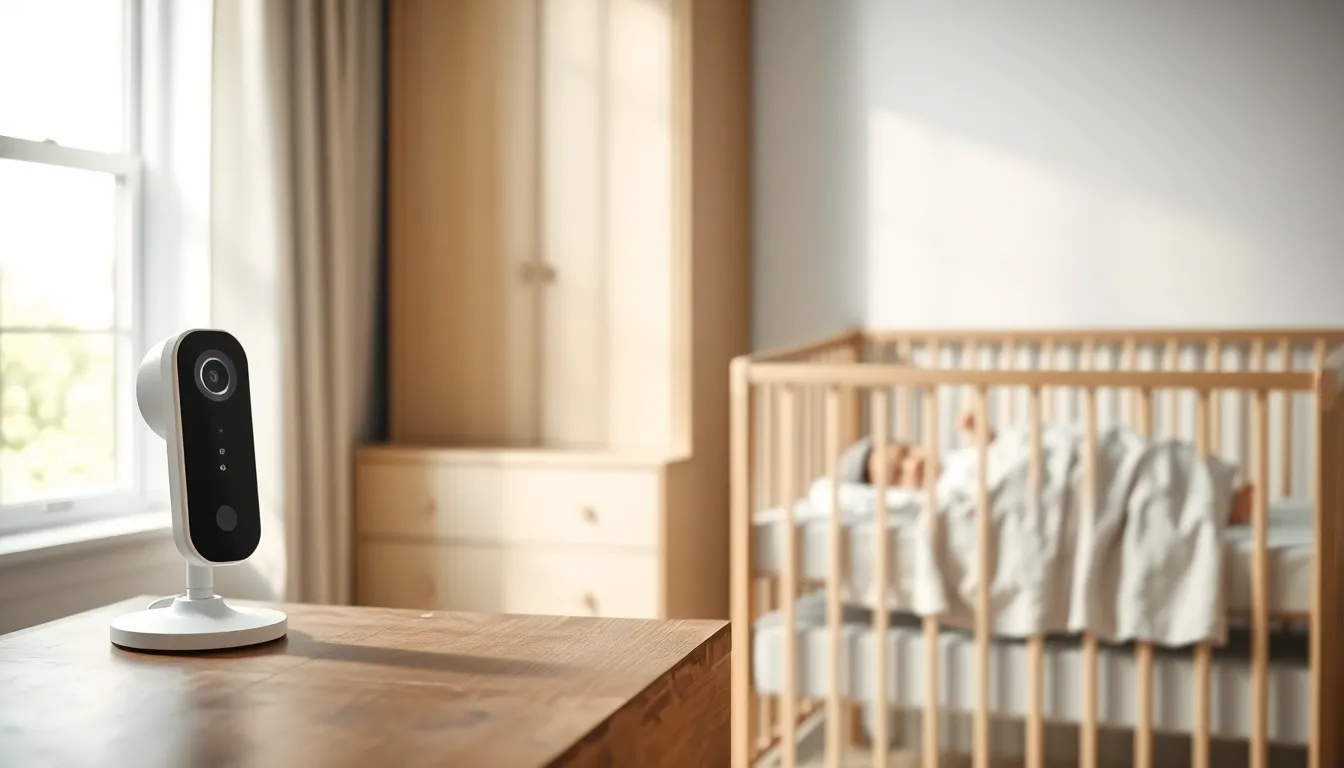Table of Contents
ToggleIn today’s fast-paced world, ensuring a baby’s safety is a top priority for parents. Baby monitors have become essential tools that provide peace of mind, allowing caregivers to keep a watchful eye on their little ones from anywhere in the home. With advancements in technology, these devices have evolved significantly, offering features that go beyond simple audio monitoring.
From video capabilities to smart connectivity, modern baby monitors cater to the diverse needs of families. Whether it’s tracking sleep patterns or monitoring room temperature, these gadgets provide invaluable support for new parents. Understanding the different types and features available can help parents make informed choices, ensuring they select the right monitor for their family’s unique needs.
Understanding Baby Monitors
Baby monitors ensure the safety of infants and keep parents informed. Various types and features exist, catering to different needs and preferences.
Types of Baby Monitors
- Audio Monitors: These monitors capture sound, allowing parents to hear their baby’s cries or movements from another room.
- Video Monitors: Video monitors provide a live feed of the baby, enabling visual monitoring of the infant’s activities and sleep patterns.
- Smart Monitors: Smart monitors connect to Wi-Fi, allowing parents to access features through smartphones or tablets. These devices often include advanced functionalities like remote viewing and notifications.
- Wearable Monitors: Wearable devices track vital signs and sleep patterns directly on the baby, offering continuous health monitoring and alerts to parents.
- Movement Monitors: These monitors detect movements and breathing patterns, alerting parents if it senses abnormal activity. They enhance peace of mind during sleep times.
Key Features to Consider
- Video Quality: High-definition video and night vision capabilities ensure clear visuals, even in low-light conditions.
- Range and Connectivity: A robust range allows signals to pass through walls and barriers, while reliable connectivity prevents interruptions during monitoring.
- Two-Way Communication: Two-way audio enables parents to speak to their baby remotely, providing comfort without needing to enter the room.
- Temperature Monitoring: Built-in thermometers display room temperature, helping parents maintain a comfortable environment for their baby.
- Battery Life: Long-lasting batteries are essential for portable monitors, ensuring functionality without frequent recharging.
- Data Storage: Cloud or local storage options allow parents to record and review audio or video clips, aiding in tracking development milestones.
Top Baby Monitor Brands

Several prominent brands dominate the baby monitor market, each offering unique features and functionalities. Parents can rely on these brands for quality and innovation in monitoring solutions.
Brand Comparisons
- Nest
Nest produces smart baby monitors that support Wi-Fi connectivity and high-definition video. Their models offer advanced features such as sleep tracking and integration with other smart home devices.
- Motorola
Motorola’s baby monitors feature extensive ranges and reliable audio and video quality. Many models include remote pan-and-zoom capabilities, allowing parents to adjust views effortlessly.
- BabyBjörn
BabyBjörn emphasizes simplicity and ease of use in their audio monitors. Their designs focus on essential functionalities without excess features, appealing to parents seeking straightforward options.
- VTech
VTech offers a wide range of affordable baby monitors with diverse features. Models include two-way communication and built-in night lights, catering to different preferences and budgets.
- Angelcare
Angelcare specializes in movement monitors that track respiration in infants. Their devices provide alerts for abnormal activity, enhancing safety for parents concerned about SIDS.
Customer Reviews
- Nest
Customers frequently praise Nest monitors for their user-friendly app and clear video quality. Many like the ability to receive alerts on smartphones, enhancing convenience.
- Motorola
Users appreciate Motorola monitors for their reliable connection and long-range capabilities. Many find the price point justifiable given the features included.
- BabyBjörn
Reviews highlight BabyBjörn’s commitment to simple design and sound quality. Customers often recommend these monitors for parents who prioritize functionality over additional features.
- VTech
VTech monitors attract positive feedback for affordability and practical features. Many users commend the battery life and ease of setup, making them ideal for budget-conscious parents.
- Angelcare
Angelcare receives high ratings for its movement monitoring capabilities. Parents value the peace of mind it provides, particularly for newborns and infants.
Benefits of Using Baby Monitors
Baby monitors provide essential benefits, enhancing the care parents can offer to their infants. They contribute significantly to ensuring safety, security, and peace of mind.
Peace of Mind for Parents
Peace of mind is a vital benefit of using baby monitors. Parents can monitor their babies’ activities in real-time, ensuring they are safe while they attend to other tasks. Many devices include features such as video feeds and two-way audio. Video feeds allow parents to visually check on their babies without entering the room, minimizing disruptions. Two-way audio enables parents to soothe their children from a distance, helping maintain a calm environment and reducing anxiety.
Safety and Security Features
Safety and security features in baby monitors significantly enhance child protection. Common features include movement detection alerts and temperature monitoring, which notify parents of any irregularities. Some monitors offer advanced functionalities, such as real-time alerts sent to smartphones, ensuring parents stay informed regardless of location. Many baby monitors incorporate encrypted signals to protect against unauthorized access, ensuring families enjoy secure monitoring experiences. Enhanced features bolster trust in device reliability, allowing parents to focus on their baby’s needs.
Drawbacks of Baby Monitors
Baby monitors can present several drawbacks that parents should consider. While they enhance monitoring capabilities, potential issues and concerns may arise with their use.
Potential Issues and Concerns
- Interference: Baby monitors may experience signal interference from other electronic devices, leading to disruptions in connectivity. This situation can cause missed alerts and decreased monitoring effectiveness.
- Privacy Risks: Wireless baby monitors, especially those with internet connectivity, pose security risks. Hacking incidents reported in recent years alert parents to the importance of securing devices with strong passwords and regularly updating firmware.
- Overreliance: Parents may develop an overreliance on baby monitors. Excessive use can lead to increased anxiety, resulting in constant checking that hinders relaxation and interferes with parental instincts.
- Battery Life and Maintenance: Monitors typically require batteries or charging, creating potential issues for parents. Dead batteries can result in missed alerts and require regular maintenance, adding to parental responsibilities.
- Limited Range: Many baby monitors have limited operational ranges. If parents venture beyond this range, they may lose connection, preventing them from monitoring their child’s safety.
Alternatives to Baby Monitors
- Audio Monitors: Basic audio monitors provide sound detection without video. These monitors focus on noise levels, allowing parents to hear their baby’s cries without visual engagement.
- Movement Sensors: Movement sensors placed under a crib alert parents to unexpected inactivity. They provide a reliable early warning system for safety without requiring video feeds.
- Smart Cameras: Smart cameras can double as security devices and baby monitors. They allow for monitoring of multiple rooms and offer remote viewing capabilities via smartphones.
- Wearable Monitors: Wearable devices track infants’ vital signs and alert parents to abnormalities. They provide peace of mind through constant monitoring without requiring a stationary unit.
- Co-Sleeping: Co-sleeping allows parents to keep their infants close while maintaining awareness of their comfort and safety. This method eliminates reliance on technology altogether.
Choosing the right baby monitor can significantly enhance a parent’s ability to ensure their child’s safety. With various types and features available parents can find a monitor that fits their lifestyle and needs. The advancements in technology have transformed these devices into essential tools that provide peace of mind and support.
While baby monitors offer numerous benefits they also come with considerations that parents should keep in mind. By weighing the pros and cons and exploring options beyond traditional monitors parents can make informed decisions that prioritize their child’s well-being. Ultimately the right baby monitor can make all the difference in creating a secure and nurturing environment for infants.




